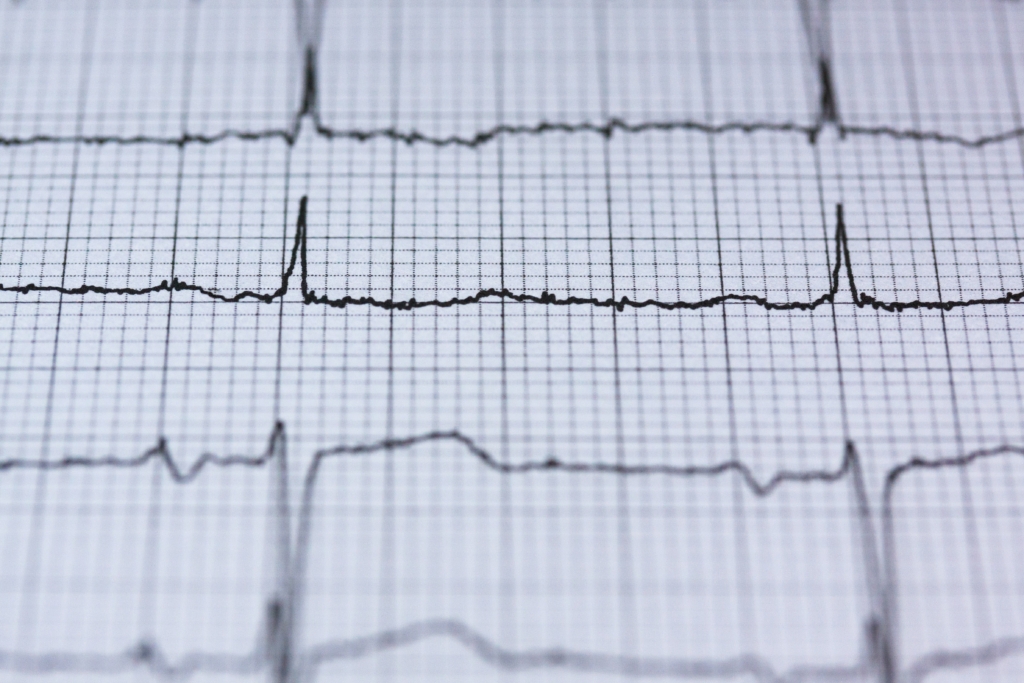Heart Rate Variability
What it is and How to Improve it.
Heart rate variability (HRV) is a measure of the variation in time between successive heartbeats, also known as inter-beat intervals (IBIs). This variation in heart rate is regulated by the autonomic nervous system (ANS), which is responsible for maintaining balance between the sympathetic nervous system (SNS), which activates the body’s “fight or flight” response, and the parasympathetic nervous system (PNS), which activates the body’s “rest and digest” response.
The ANS is constantly adjusting the balance between the SNS and PNS to respond to changes in the environment and maintain homeostasis. This balance is reflected in the heart rate variability, which is a non-invasive and easily measurable marker of ANS function. A high HRV reflects a balance between the SNS and PNS, while a low HRV indicates an imbalance favoring one or the other.
Heart rate variability is not just a marker of ANS function but also a predictor of overall health and disease risk. A growing body of research has shown that low HRV is associated with various health conditions such as cardiovascular disease, diabetes, and depression, among others. In contrast, high HRV has been linked to better physical and mental health, improved cognitive function, and increased resilience to stress.
Why Heart Rate Variability Matters
Heart rate variability is a valuable tool for assessing ANS function and predicting health outcomes. By measuring HRV, we can gain insights into the body’s stress response, overall health, and risk for disease. Here are some of the key reasons why HRV matters:
- ANS Function: HRV provides a non-invasive and easily measurable marker of ANS function. By monitoring HRV, we can assess the balance between the SNS and PNS and track changes over time. This information can be used to identify underlying health issues, such as autonomic dysfunction or dysregulation.
- Stress Response: HRV reflects the body’s response to stress. When we experience stress, our SNS is activated, which increases heart rate and decreases HRV. Chronic stress can lead to decreased HRV, indicating an imbalance in the ANS and increased risk for disease. Monitoring HRV can help individuals identify when they are experiencing stress and take steps to reduce it.
- Disease Risk: Low HRV has been linked to increased risk for various health conditions such as cardiovascular disease, diabetes, and depression, among others. By measuring HRV, we can identify individuals who are at increased risk for these conditions and take preventative measures.
- Health and Performance: High HRV has been associated with better physical and mental health, improved cognitive function, and increased resilience to stress. By monitoring HRV and taking steps to increase it, individuals can improve their overall health and performance.
Ways to Improve Heart Rate Variability
HRV is a dynamic measure that can be improved through various lifestyle interventions. Here are some evidence-based ways to improve HRV:
- Exercise: Regular exercise has been shown to increase HRV by improving ANS function and reducing inflammation. A study published in the Journal of Cardiopulmonary Rehabilitation and Prevention found that 8 weeks of aerobic exercise training increased HRV in patients with heart failure (1). Another study published in the International Journal of Cardiology found that a single bout of moderate-intensity exercise increased HRV in healthy individuals (2).
- Meditation: Mindfulness meditation and other forms of relaxation techniques have been shown to increase HRV by reducing stress and promoting relaxation. A study published in the Journal of Alternative and Complementary Medicine found that 8 weeks of mindfulness meditation training increased HRV in individuals with anxiety and depression (3). Another study published in the Journal of Psychophysiology found that a single session of deep breathing meditation increased HRV in healthy adults (4).
- Sleep: Sleep quality and duration are important factors that can affect HRV. Getting enough high-quality sleep is essential for maintaining ANS balance and promoting HRV. A study published in the Journal of Sleep Research found that poor sleep quality was associated with decreased HRV in healthy adults (5). Also see our blog post – Unlocking the Power of Sleep and Dreams: A Comprehensive Guide to Improving Sleep Quality and Dreaming – for more details on how you can improve your sleep, and your HRV!
- Diet: Diet can also play a role in HRV. A diet high in fruits, vegetables, and whole grains has been associated with increased HRV, while a diet high in processed foods, sugar, and saturated fat has been linked to decreased HRV. A study published in the Journal of the American College of Cardiology found that a Mediterranean-style diet, which is high in fruits, vegetables, whole grains, and healthy fats, was associated with increased HRV in individuals at high risk for cardiovascular disease (6).
- Breathing Techniques: Breathing techniques such as slow and deep breathing have been shown to increase HRV by promoting relaxation and reducing stress. A study published in the International Journal of Behavioral Medicine found that slow and deep breathing increased HRV in healthy adults (7).
- Biofeedback: Biofeedback is a technique that uses electronic devices to measure and provide feedback on physiological processes such as HRV. By providing real-time feedback, individuals can learn to control their ANS and increase HRV. A study published in the Journal of Alternative and Complementary Medicine found that HRV biofeedback improved ANS balance and increased HRV in individuals with chronic obstructive pulmonary disease (8).
- Yoga: Yoga is a mind-body practice that incorporates physical postures, breathing techniques, and meditation. It has been shown to increase HRV by promoting relaxation and reducing stress. A study published in the International Journal of Yoga found that a 12-week yoga intervention increased HRV in individuals with chronic low back pain (9).
How Does Spiritual Practice Affect HRV?
I’ve been tracking my own HRV for a few years now. After correlating my HRV with my spiritual practices, there are a few trends that I’ve noticed:
- QHHT® – *significantly* increased my HRV up into the 120 range for three days following my session. (To schedule an in-person QHHT® session with me, please visit: https://rowan-wellness.com/services-scheduling/.)
- Psychedelics – During my ayahuasca experience, my personal HRV was low-medium. In the days immediately following, it was higher than average (100+).
- Shamanic Journey, Reiki, Vibrational Healing (Sound, Stone): Not as high as QHHT® initially, but a definite and sustained increase to 90-100+ range. (To schedule any of these sessions with me, please visit: https://rowan-wellness.com/services-scheduling/. Note that all but hands on vibrational therapies can be done online as well.)
- Alcohol, pharmaceuticals – I’ve noticed anytime I drink alcohol (and no, number of drinks doesn’t seem to matter), my HRV plummets down to 30-40. Though I very rarely take pharmaceuticals, after a recent short course of them I noticed the same effect.
- Bad Stress Days – effect similar to (3.) above.
- “Good” Stress Days – On days that I do a lot of strenuous activity, such as working outside, I notice a lower value that night, but an increase in the days following.
This is obviously a thrilling validation of energy work, hypnotherapy, and the amazing potential of psychedelics in healing. But more than that, these tangible effects provide helpful mental goalposts as we go through our day to day lives, seeing what works and what’s unhelpful.
Why are some benefits immediate and others are delayed? I believe it has to do with the intensity of the work done as well as overall integration. Integration can be nearly spontaneous with methods such as QHHT and other energetic work as integration often happens seamlessly within those processes. Very intense work – such as shadow work or trauma release – can temporarily exhaust; thus one must often pass through a period of recovery and then subsequently work towards integration. Once those stages have been passed through, then the HRV begins to reflect the newly healthful state. (For more information on Integration, please visit our article: Integration from a Spiritual Perspective.)
(Keep in mind that the values I listed above are my own personal ranges; your actual values will be reflective of you personally.)
Interpreting Your Personal Heart Rate Variability Values
Heart rate variability (HRV) ranges can vary depending on a variety of factors such as age, gender, and overall health. Generally, a higher HRV indicates better cardiovascular health and overall resilience, while a lower HRV may indicate an increased risk for developing cardiovascular disease and other health issues.
In terms of specific HRV ranges, it is important to note that there is no universal range that applies to everyone. Instead, HRV should be assessed on an individual basis, taking into account factors such as age, gender, and overall health.
That being said, some general guidelines can be used as a starting point for interpreting HRV values. According to the American Heart Association, a normal resting heart rate (RHR) for adults ranges from 60 to 100 beats per minute (bpm). However, it is important to note that HRV measures the variation in time between heartbeats, rather than the number of beats per minute.
In terms of HRV values, a higher value indicates greater variability in the time between heartbeats and is generally considered a positive sign. The normal range for HRV is typically between 30 and 100 ms, although this can vary depending on the measurement device and the specific analysis method used.
When it comes to interpreting HRV values, it is important to consider a variety of factors. Age and gender, for example, can impact HRV values. In general, HRV tends to decrease with age, meaning that older individuals may have lower HRV values compared to younger individuals. Additionally, some studies have suggested that women may have slightly higher HRV values compared to men, although the differences are typically small.
Heart rate variability is a valuable tool for assessing ANS function and predicting health outcomes. By monitoring HRV and taking steps to improve it, individuals can improve their overall health and performance. Evidence-based interventions such as exercise, meditation, sleep, diet, breathing techniques, biofeedback, and yoga can all play a role in increasing HRV and promoting ANS balance.
References:
- Bocalini, D. S., dos Santos, L., de Andrade, S., & Rocha, N. (2016). Effects of Aerobic Exercise Training on Heart Rate Variability in Patients With Heart Failure. Journal of Cardiopulmonary Rehabilitation and Prevention, 36(4), 276–280. https://doi.org/10.1097/hcr.0000000000000173
- Michael, S., Graham, K. S., & Davis, G. M. (2017). Cardiac Autonomic Responses during Exercise and Post-exercise Recovery Using Heart Rate Variability and Systolic Time Intervals—A Review. Frontiers in Physiology, 8. https://doi.org/10.3389/fphys.2017.00601
- Klainin-Yobas, P., Cho, M. A., & Creedy, D. K. (2012). Efficacy of mindfulness-based interventions on depressive symptoms among people with mental disorders: a meta-analysis. International Journal of Nursing Studies, 49(1), 109–121. https://doi.org/10.1016/j.ijnurstu.2011.08.005
- Pal, G. K., Velkumary, S., & Madanmohan. (2004). Effect of short-term practice of breathing exercises on autonomic functions in normal human volunteers. Indian Journal of Medical Research, 120(2), 115–120
- Tobaldini, E., Costantino, G., Solbiati, M., Cogliati, C., Kara, T., Nobili, L., Montano, N., & Porta, A. (2017). Sleep, Sleep Deprivation, Autonomic Nervous System and Cardiovascular Diseases. Neuroscience & Biobehavioral Reviews, 74(Pt B), 321–329. https://doi.org/10.1016/j.neubiorev.2016.07.004
- Papadaki, A., Martínez-González, M. Á., Alonso-Gómez, Á. M., Rekondo, J., Salas-Salvadó, J., Corella, D., Ros, E., Castañer, O., Fitó, M., & Estruch, R. (2020). Mediterranean Diet and Heart Rate Variability: A Cross-Sectional Analysis of the PREDIMED-Plus Trial. Journal of the American College of Cardiology, 75(18), 2279–2291. https://doi.org/10.1016/j.jacc.2020.02.055
- Lehrer, P. M., Vaschillo, E., Vaschillo, B., & Lu, S.-E. (2013). The Heart Rate Variability Biofeedback Handbook: A Guide to Resilience Training for Health Care Practitioners. WW Norton & Company.
- Jones, L. W., Watson, D., Herndon, J. E., Eves, N. D., Haithcock, B. E., Loewen, G., Kohman, L., & Quist, M. (2014). Peak oxygen consumption and heart rate recovery in patients with lymphoma undergoing autologous stem cell transplantation. Oncologist, 19(6), 583–590. https://doi.org/10.1634/theoncologist.2014-0054
- Tekur, P., Nagarathna, R., Chametcha, S., Hankey, A., & Nagendra, H. R. (2012). A comprehensive yoga programs improves pain, anxiety and depression in chronic low back pain patients more than exercise: An RCT. Complementary Therapies in Medicine, 20(3), 107–118. https://doi.org/10.1016/j.ctim.2011.12.009
Schedule a Session With Me
If you’d like to go deeper in a supportive, healing environment, please visit my scheduling page.


